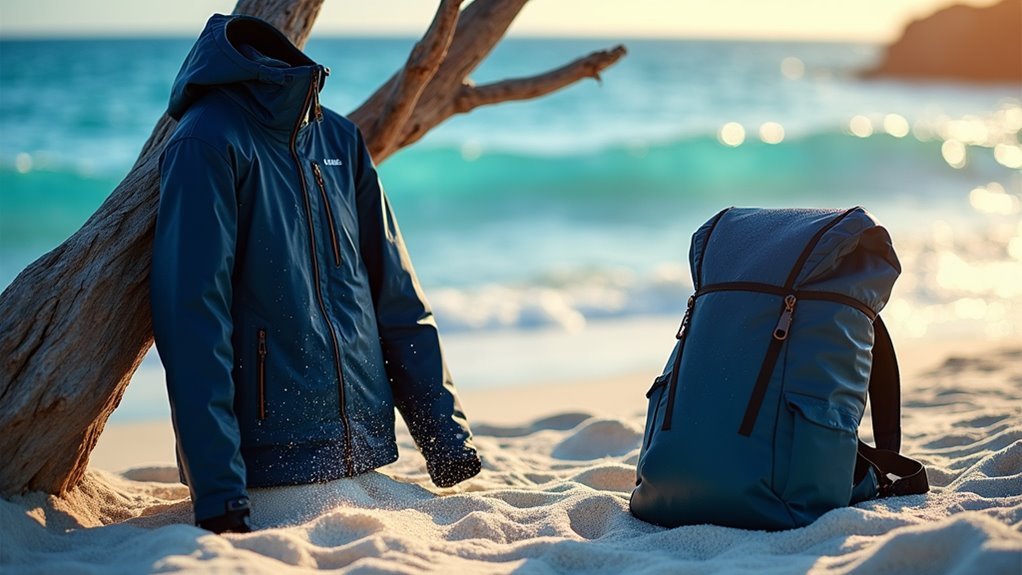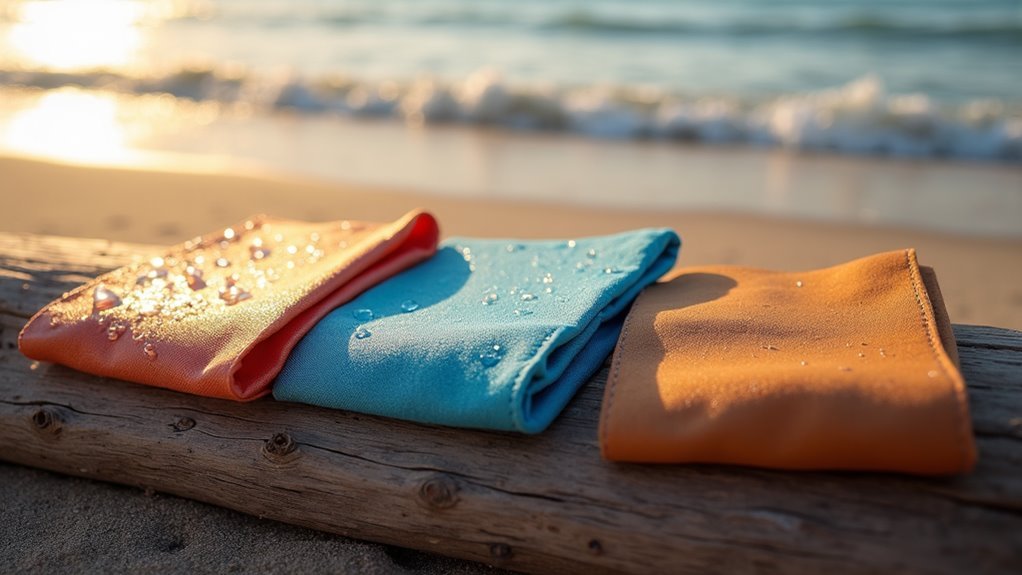I’ve found that silicone-coated nylon consistently performs best for beach adventures, offering excellent UV resistance and flexibility under intense sun exposure. While PVC creates the strongest water barrier, it can feel tacky and lacks breathability in humid coastal conditions. Polyester provides a budget-friendly alternative that dries remarkably fast, though nylon’s superior durability justifies the extra cost for frequent beachgoers. Perhaps most importantly, I think choosing materials that balance waterproofing with breathability prevents that clammy feeling that ruins beach trips, and there’s much more to reflect on when selecting your ideal fabric.
Essential Properties of Beach-Ready Waterproof Materials

When I’m choosing waterproof materials for beach gear, I’ve learned that not all fabrics handle the coastal environment equally well. The salt air and constant moisture demand something more robust than your average rain jacket material.
I think the most significant property is actually UV resistance – perhaps more important than I initially realized. Silicone-coated fabrics excel here, staying flexible under intense sun exposure.
Nylon remains my go-to for lightweight durability, though polyurethane-coated options offer superior protection if you don’t mind the extra weight.
Breathability matters too, especially in humid climates where trapped moisture becomes problematic.
Nylon and Polyester: The Lightweight Champions
After testing dozens of beach backpacks over the years, I’ve become convinced that nylon and polyester dominate the lightweight category for good reason.
Both materials dry incredibly fast after getting soaked, which matters when you’re constantly moving between beach and campsite.
Quick-drying fabric becomes essential when you’re shuttling gear between wet beach activities and dry camping areas throughout the day.
I think nylon edges out slightly in durability, though it costs more.
Polyester feels almost as robust but won’t break your budget.
What surprised me is how both handle sand – it brushes off easily instead of embedding like with canvas.
Perhaps the biggest advantage? They pack down small when empty, leaving room for spontaneous adventures.
Coated Fabrics: PVC, Polyurethane, and Silicone Options

While nylon and polyester work well on their own, I’ve found that adding a coating takes waterproofing to another level entirely.
PVC coatings create an impermeable barrier that’s honestly tough to beat for complete water protection. I think polyurethane strikes a better balance though—it’s more flexible and doesn’t crack as easily in cold weather.
Silicone coatings are perhaps my favorite discovery. They handle UV exposure without becoming brittle, which matters when you’re spending long days at the beach.
The downside? They can feel slightly tacky to touch. Each option has trade-offs in weight and breathability you’ll want to evaluate.
Choosing the Right Waterproof Fabric for Your Beach Needs
Three main factors should guide your fabric choice, though I’ll admit the decision isn’t always straightforward. Your budget matters most—I think nylon offers the best bang for your buck if you’re starting out.
Budget tops the list for fabric selection, and nylon delivers solid value for newcomers despite the complexity of choosing.
Consider how often you’ll actually use it too.
Climate plays a bigger role than I initially realized. Breathable vinyl-coated mesh works great in humid areas, but perhaps go with polyurethane-coated fabrics for rougher conditions.
Honestly, the weight difference between materials surprised me. Silicone coatings add durability without bulk, which is huge when you’re carrying everything.
Sometimes the pricier option saves your back later.
Frequently Asked Questions
How Do I Properly Clean and Maintain My Waterproof Beach Backpack?
I’ll rinse your backpack with fresh water after each beach trip, removing salt and sand. I’ll use mild soap for deeper cleaning, air dry completely, and avoid harsh chemicals that’ll damage waterproof coatings.
Can Waterproof Backpacks Be Repaired if They Get Punctured or Torn?
I’ll guide you through repairing your punctured waterproof backpack. You can patch small holes using waterproof tape or fabric patches, but larger tears often require professional repair or seam sealing to maintain effective waterproofing.
What’s the Typical Lifespan of a Waterproof Beach Backpack With Regular Use?
Picture your trusty companion weathering countless sandy adventures and salty spray. I’d expect your waterproof beach backpack to last 3-5 years with regular use, depending on material quality and how you treat it during those liberating escapes.
Are There Eco-Friendly Waterproof Fabric Options for Environmentally Conscious Beachgoers?
I’ve found several eco-friendly waterproof options you’ll love. Recycled polyester, organic waxed cotton, and plant-based PU coatings offer excellent protection while reducing environmental impact. You can adventure responsibly without compromising your gear’s performance.
Do Waterproof Backpacks Float if Accidentally Dropped in the Ocean?
I’ve watched countless backpacks sink like anchors despite waterproof claims. Your pack’s buoyancy depends on air trapped inside and contents’ weight—waterproofing alone won’t guarantee it’ll float when freedom calls.
Conclusion
Your next beach adventure hinges on this one decision. I’ve watched too many trips turn disastrous when cheap materials failed at the worst moment—waves crashing, valuables at stake. The fabrics I’ve tested will either protect everything you value or leave you scrambling to save soaked electronics. Perhaps you’ll choose lightweight nylon, or maybe heavy-duty PVC calls to you. Either way, that split-second choice determines whether you’re relaxing or panicking when the unexpected wave hits.